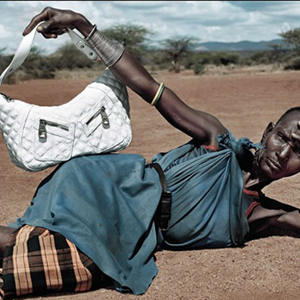
Whether it's a fashion editorial glorifying gang rape on a bus in India or a glam magazine shoot depicting models drunk and passed out in an alley (yes, this has actually been put in print); controversial, thought-provoking and often slightly sickening campaigns always get my attention. Mostly, because I want to slap someone and ask the creatives behind the project what the hell they were even thinking. Promoting I-blacked-out-in-an-alley chic?! No words.
Luckily, every now and again such a campaign pops up; only this time, it's one aimed at helping people.
So, when I scrolled down my Facebook feed last night I noticed a line that read: "8-year-old campaign goes viral", I immediately took notice.
In 2007, Cordaid combined forces with advertising giant, Saatchi & Saatchi to create a rather extraordinary campaign. It even won the ad agency a much-coveted Cannes Silver Lion award. Shot by Swedish high-fashion and advertising photographer, Calle Stoltz, these images are controversial, thought-provoking, and yes, slightly sickening - mainly because it's like a reality smack.
The campaign's goal? To show the average jane and joe how their consumer behaviour can actually change the world. Some things we spend money on, things that we sometimes don't even think twice about, actually have the ability to change someone's life for the better.
Well, for example buying an averagely priced handbag of R350, is much the same as the amount needed for some people to live on each week. That is the cost of a week's groceries. So ask yourself, do you really need another tassel bag?
The eye-catching campaign was shot in Northern Kenya during a time of extreme drought. The pictures show local members of the Samburu people, a nomadic tribe related to the Masai, holding items that, for the most part, are completely foreign to them. Consumer goods like a cold beer, a pair of sunglasses, a handbag and perfume were given to a few selected local people. And they were told to pose with this alien thing.
#peopleinneed #ad pic.twitter.com/mfKatnZqMR
— papi çülo (@yamuksandalye) May 6, 2015So proud of Calle Stoltz, photographer of this amazing campaing going viral 8 years later. #peopleinneed #cordaid pic.twitter.com/AF93p2ZfGV
— MINK MGMT. (@MINKMGMT) March 13, 2015Campagna pubblicitaria di qualche anno fa #Cordaid #PeopleInNeed https://t.co/xUvp6BghIc pic.twitter.com/ii8xkjrHzp
— . (@balossu) May 20, 2015
Judith Maat, of Cordaid, says that the Samburu people have never before seen a fashion magazine - thus they were pretty much confused as to what posing for a photo shoot meant. Seeing such stark images of people who don't have much in the ways of material/earthly possessions or even some primary resources like water and food - is almost reminiscent of the poverty porn shoots we see so often in glossy mags. Only this time, it's the poor holding the luxury goods instead of a model posing in uber expensive designer labels whilst standing in a squatter camp.
What I love about these controversial, thought-provoking, and yes, slightly sickening images is that it was meant to make you uncomfortable. And you know it's a great campaigns when you get that stomach-flip. You know the one, where you suddenly start to question your entire existence.
These photos were meant to confront people with their consumer behaviour. That it did in 2007, but I'm guessing so much more now. Today, the complete and utter waste and over consumption of goods have reached gargantuan levels. That's why I think a campaign like this is more important than ever.
I completely agree with what Judith Maat of Cordaid says when she says that the bottom line here is to face the utterly ridiculous wealth inequality that so many countries face. Something has got to change - and soon.




 Publications
Publications
 Partners
Partners










